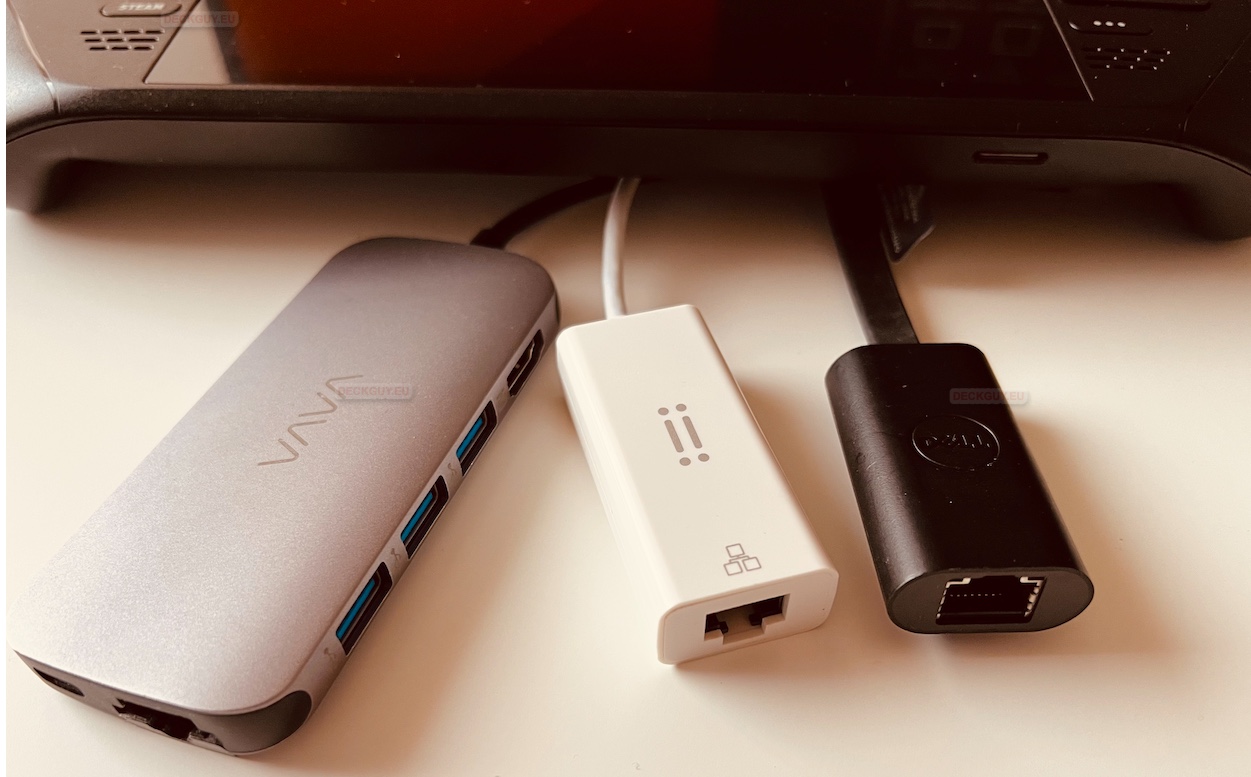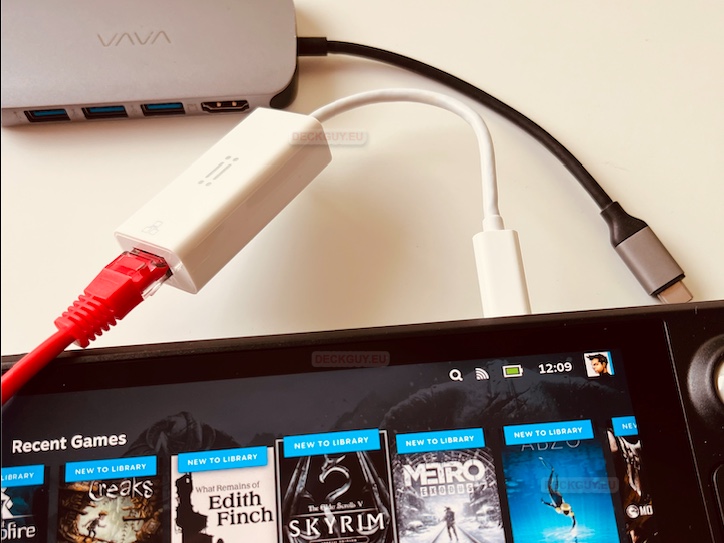I was testing syncing and backup from Steam Deck via ethernet cable, and although there were about 62000 tiny files to sync, I was still interested why my ethernet speed was not optimal. In this short guide, we are going to see how to connect our Steam Deck with ethernet cable, and test performance of wi-fi and ethernet.
I like better and always use ethernet connection when I can – it proved useful to transfer my games and installations to Steam Deck – ethernet is still faster than Wi-Fi and can give 100MB/s connection, while even with powerful router (I have Asus AX11000) Wi-Fi is still not there.
So, what are our options, and how does ethernet work with Steam Deck?
Can I connect anything else to Steam Deck besides official Dock for ethernet connection?
You don’t need Steam Dock to connect your Steam Deck to you local network ethernet – you just need USB-C to Ethernet adapter, or USB-C hub that will have ethernet on it.
Be careful with third party USB-C adapters and hubs if they provide power, they could in rare cases fry your Steam Deck – it is not common occurrence, but please have that in mind when buying third party powered equipment for USB-C!
I tested with VAVA va-uc006 hub (has ethernet on it among other ports), Dell USB-C ethernet adapter (DBQBCBC064) and some white USB-C to ethernet adapter that says nothing on it about model – it all worked.

Your main concern with this type of connection is that – you won’t be able to charge at the same time you use ethernet connection – your only USB-C port is used by adapter. That’s why things like Steam Dock provide additional value, they can charge your device at the same time they provide additional ports and a stand for your Steam Deck.
I currently use my laptops dock for Steam Deck – Dell ThunderBolt Dock WD19TBS – it works great with Steam Deck. I will probably in some period get also the Steam Dock, when I financially recover 🙂
Wi-Fi Vs Cable (Ethernet)
Wi-Fi
My router is supporting Wi-Fi 6 (802.11ax) which could provide in theory from 574Mbit/s up to 9608 Mbit/s (9.6Gbit). Wi-Fi 5 (802.11ac) which Steam Deck supports could provide in theory from 433Mbit/s to 6933Mbit/s (6.9Gbit).
In megabytes – which we love to see when we copy games or download the from internet that means we could copy in Wi-Fi 6 from 71MB/s up to 1.2GB/s (yes gigabytes). Wi-Fi 5 should be able to deliver from 54MB/s up to 866MB/s – that is still a lot.
But that is all in theory – because, if we want here speeds, we need powerful antennas and hardware, and that also means – higher power consumption – faster battery depletion. So, in practice – you will see speeds towards lower end, not higher.
Ethernet
In you home environment – you probably have (if you don’t have 20 years old router or switch) 1Gbit ethernet connection – which means 100MB/s transfer speeds – 125MB/s to be precise. Looks much lower then Wi-Fi – yes. But if connection is proper, and let’s say you copy large ISO or bin file – that speed will be constant.
Of course you have 10Gbit (1.2GB/s), 25Gbit and faster ethernet switches and routers, but that is (unfortunately) still to this day enterprise grade equipment. 10+ Gbit networks can be burden for CPU and can be power hungry.

Testing Wi-Fi
File Copy
I’m going to use three machines in these test – QNAP “server” from which we are copying .ISO file (SQL Server Trial 4.4GB) is 10Gbit NAS machine and the disks on which I’m hosting .ISO for testing are on NVMe Samsung SSDs – plenty fast. Router Asus AX11000 is Wi-Fi 6 and has 2.5Gbit LAN port which is connected to 10Gbit ethernet switch – so, in Wi-Fi mode our devices should be able to deliver up to 312MB/s.

I will be testing Wi-Fi and LAN speeds with my Dell laptop and Steam Deck.
Dell XPS 9710 with i9 CPU is Wi-Fi 6 capable machine – with NVMe disk drive, and according to Windows stats – should be able to deliver up to 150MB/s via Wi-Fi – both Dell XPS and Steam Deck are in the same space with great Wi-Fi signal, without any obstacles between them.

This is what I was able to get through Wi-Fi by copying ISO from server to Dell XPS – stable 33-34MB/s

Steam Deck is according to specs on official page Wi-Fi 5 (802.11ac) capable – my model has 512GB of storage – so storage should not be bottleneck, Steam Deck is in same space near router, without obstacles.
I was getting between 40-50MB/s speeds when copying same .ISO to Steam Deck via Wi-Fi

So, ok speeds, not bad, but not perfect either.
Measure Wi-Fi network performance
This part of the test we are going to do with Microsoft Ethr tool – it is Local Network Performance Tool – just like speedtest.net is for internet. It is cross platform, so there are Windows, Linux and Mac versions – great.
For this test, I have another Mac server with 10Gbit interface to which my Dell and Steam Deck will be connecting. Mac also has fast NVMe storage.
On server, I’m going to start ./ethr -s -port 8888 so that our Mac is acting like server


Clients (Dell XPS and Steam Deck) I’m going to test with following command. 192.168.1.40 is IP address of our ethr server we set above. Test is measuring upload and download part from client and part from server side
Command below will test bandwidth.
ethr -c 192.168.1.40 -n 8
Dell XPS measurements
So, bandwidth isn’t problem, Wi-Fi has enough throughput

Mac Server Measurements for Dell XPS – good throughput – between 500Mbit/s and 1.1Gbit

You may now conclude that something on the server I’m copying from for a test is not right – wi-fi copy speeds should be higher – look at the Thunderbolt measurements I prepared below – same hardware, same files, only thunderbolt connection.
Steam Deck Measurements
From the measurements below, looks like Steam Deck did it best while it copied that .ISO file.
From Steam Deck these are the results – around 350Mbit/s

From server side, Steam Deck looks like this

Thunderbolt Measurement results
Steam Deck is not Thunderbolt enabled, but just for reference – what can Thunderbolt interface do, this is close to 10Gbit in results, and it was copied on Dell XPS from same server and same folder I used in my test above for .ISO copying.
I couldn’t just give it one .ISO file of 4.4GB because it is copying so fast I wasn’t quick enough to screenshot. So, this is 29.5GB for reference.


Let’s move to LAN
Measure Ethernet network performance
Ok, we have Wi-Fi and Thunderbolt speed and bandwidth for reference, from ethernet I don’t expect much, since my Dell XPS and Steam Deck Ethernet adapters are 1Gbit – so I should get 1Gbit in speed. Servers from which I’m copying .ISO and measuring ETHR are 10Gbit capable, along with network switch which is 10Gbit.
To prove that we can get 10Gbit, here is the result of 30GB of data copy (again from same folder I’m using for test with Dell and Steam Deck) from QNAP server to Mac server.
Again, I could’t just copy that 4.4 GB ISO file that I used above, and will be using here, because I wasn’t fast enough to screenshot.
Reference – Ethernet speed between QNAP and Mac Server (both 10Gbit network cards)
I’m getting 1.2GB/s from the network


File Copy
Dell XPS 9710 has following speed when copying 4.4GB .ISO from QNAP server
Expected – we are getting full 1Gbit from our cable.

Steam Deck has following measures when taken with ethernet cable – so, it is also using full 1Gbit in performance.

Ethernet Network Performance
We will also measure quickly with ethr tool, both on Dell and Steam Deck
Dell XPS measurements
On Dell XPS I got following values

On Mac server I got following values for Dell XPS

Steam Deck Measurements
On Steam Deck, also nice and as expected – almost full 1Gbit

Measurements on Mac Server for Steam Deck are also very nice

Conclusion
If you have large transfers for your Steam Deck inside your local network (not from internet) – let’s say you want to copy your GOG Steampunk 2077 install to Steam Deck – use ethernet, it has double the speed of wi-fi (if not more, depending on your Wi-Fi).
If you are completely in SSD world with USB 3.0+ speeds (both your server that is holding the game, external storage and Steam Deck have SSD) you should be even better with external SSD drive.
If you have more than 500Mbit internet speed – also, when downloading something from internet for your Steam Deck – ethernet is better solution.
Ethernet is always better solution than Wi-Fi if you have access to it. Period.
Also ,don’t be like me, I was puzzled why on Steam Deck in Network Connection settings – my Wired connection was 100Mbit/s and greyed out so I could not change it – I thought – why am I limited to 100Mbit/s on my ethernet connection – truth is – you have Ignore set in the field above, so that setting i ignored.
If you change to manual or Automatic – then be sure to change speed to 1Gbit or more, and Duplex to Full (if your network is supporting both settings in that way).

